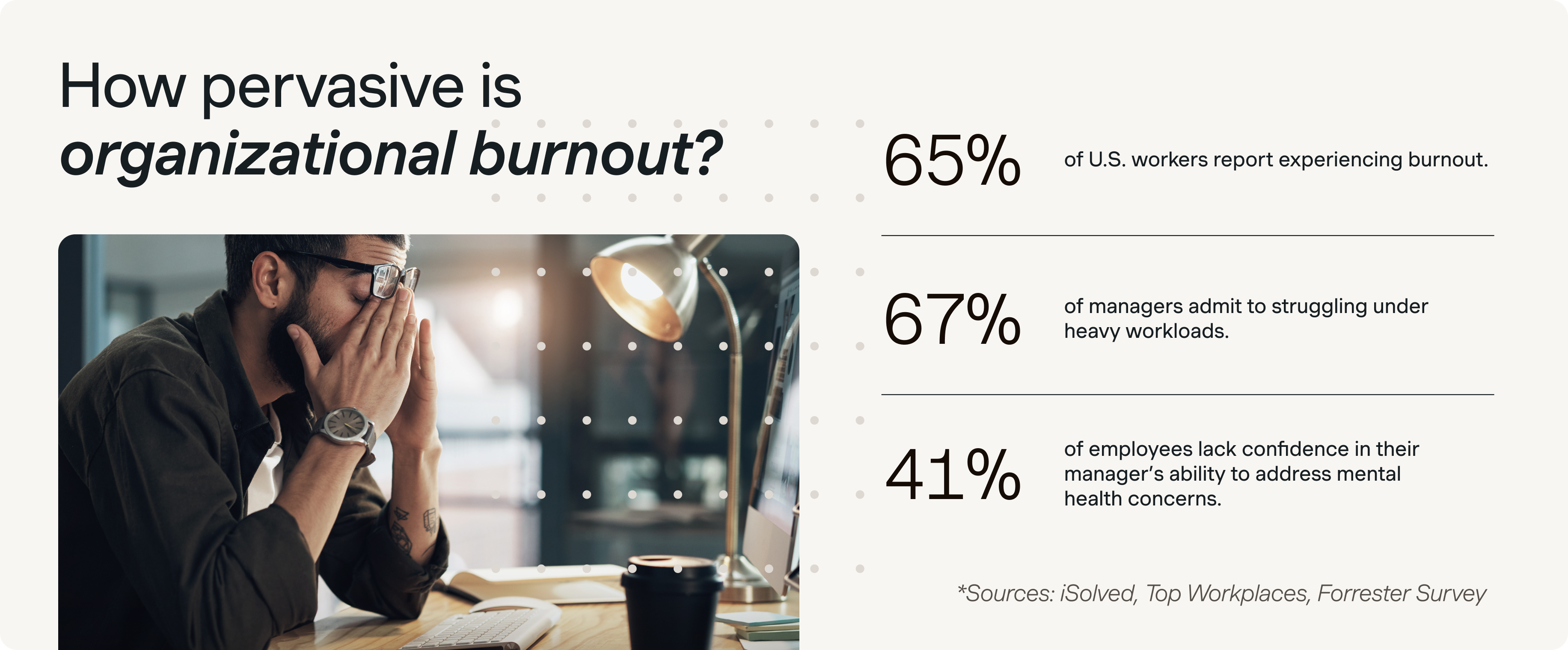Burnout isn’t new, but the way organizations need to address it is rapidly evolving. Employee burnout is now recognized for what it truly is: a systemic, organizational risk impacting your business’s productivity, healthcare costs, employee retention, and overall performance.
The data makes this clear: According to Forrester’s Q1 2025 Mental Health Benefits survey, 65% of employees are as stressed or more stressed as they were five years ago. And that level of burnout affects your organization in a variety of ways. It’s an issue that simply can’t be ignored.
The evolving view of burnout
Traditionally, burnout was misunderstood as merely stress or a lack of personal resilience. Today, the World Health Organization officially defines burnout as:
A syndrome conceptualized as resulting from chronic workplace stress that has not been successfully managed.
This shift in perspective acknowledges burnout as an organizational phenomenon—not just a personal struggle.
How burnout impacts organizational performance
Burnout isn’t confined to the emotional state of your employees; it fundamentally affects your organizational outcomes. The consequences of burnout ripple through key areas such as productivity, retention, and healthcare costs:
- Increased absenteeism and turnover: Employees experiencing burnout have a 57% increased risk of workplace absence greater than two weeks and are 2.8 times more likely to actively search for a new job.
- Productivity losses: Burnout drives feelings of cynicism, exhaustion, and reduced productivity, significantly affecting team effectiveness and morale.
- Rising healthcare costs: Burnout-related health issues contribute to billions in healthcare expenditures, adding to the financial burdens organizations must bear.

Identifying the systemic causes of burnout
To address burnout effectively, organizations must first understand its root causes. According to contemporary behavioral health research featured in our Burnout Nation guide, key factors driving employee burnout include:
- Financial stress (37% of employees impacted)
- Work-related stress, including unrealistic workloads and deadlines (17%)
- Poor work-life balance (14%)
Burnout is further exacerbated by external pressures, such as economic uncertainty, global instability, and community trauma. While leaders can’t eliminate these external stressors entirely, they do have substantial influence over the workplace environment and the tools employees have to manage these challenges.
Why traditional approaches are no longer effective
For decades, traditional Employee Assistance Programs (EAPs), occasional mental health days, or wellness stipends have been the default solutions for managing burnout. However, today’s workplace realities demand a far more sophisticated approach.
According to Forrester Consulting research commissioned by Spring Health, organizations are increasingly scrutinizing the ROI of their mental health investments. CFOs and business leaders need clear evidence that their strategies work—not just in theory, but through demonstrated reductions in healthcare claims, absenteeism, and turnover.
Simply put, a "check-the-box" approach is no longer sufficient. Burnout is a complex, evolving risk that requires comprehensive, clinically backed, and personalized interventions.
What effects is burnout having at your organization?
Book a meeting to see how Spring Health can help.
Strategic interventions to prevent burnout
The good news is that burnout can be managed. Leading organizations are already leveraging innovative strategies to proactively tackle burnout as an organizational risk. These include:
Proactive identification and early intervention
Early recognition is critical. Organizations should utilize validated assessments, regular pulse surveys, and structured manager check-ins to quickly identify burnout symptoms before they escalate into severe crises.
Personalized and integrated mental health care
Personalized care not only meets employees where they are but also provides measurable outcomes. Effective solutions today offer:
- Fast access to personalized mental health care (appointments within days, not weeks).
- Data-driven precision care that tracks progress and outcomes.
- Demonstrated, validated ROI to confirm that investments in mental health tangibly benefit your organization’s bottom line.
Building manager resilience
Managers are uniquely positioned to identify and mitigate burnout—but only if they are supported themselves.
Equip managers with leadership training focused on recognizing burnout signs and providing proactive support to their teams. Ensure managers have their own dedicated mental health resources, reinforcing their capacity to lead effectively and authentically.
Embedding belonging and purpose
Belonging and purpose significantly reduce burnout risks. Organizations must actively cultivate meaningful connections among employees by clearly linking individual roles to the broader organizational mission, offering ongoing career growth opportunities, and fostering a supportive, purpose-driven culture.
The business case for a proactive burnout strategy
Consider the alternative: organizations failing to proactively manage burnout face increasing healthcare expenses, high turnover rates, declining morale, and reduced productivity. Conversely, those investing strategically in burnout prevention realize measurable business outcomes:
- Reduced healthcare costs and absenteeism.
- Increased employee retention and enhanced workforce stability.
- Improved overall productivity and business performance.
Burnout management is no longer just a nice-to-have—it’s a strategic imperative.
Ready to experience organizational burnout change?
We can help. Schedule time with us today.

Dan Harrah is a licensed clinical social worker, former behavioral health benefits consultant and health plan operations leader. Dan leads Spring Health's Clinical Partnerships team, where he spends most of his time working with customers to build strategies to support the emotional wellbeing needs of employees and their families.










_405x405.png)





